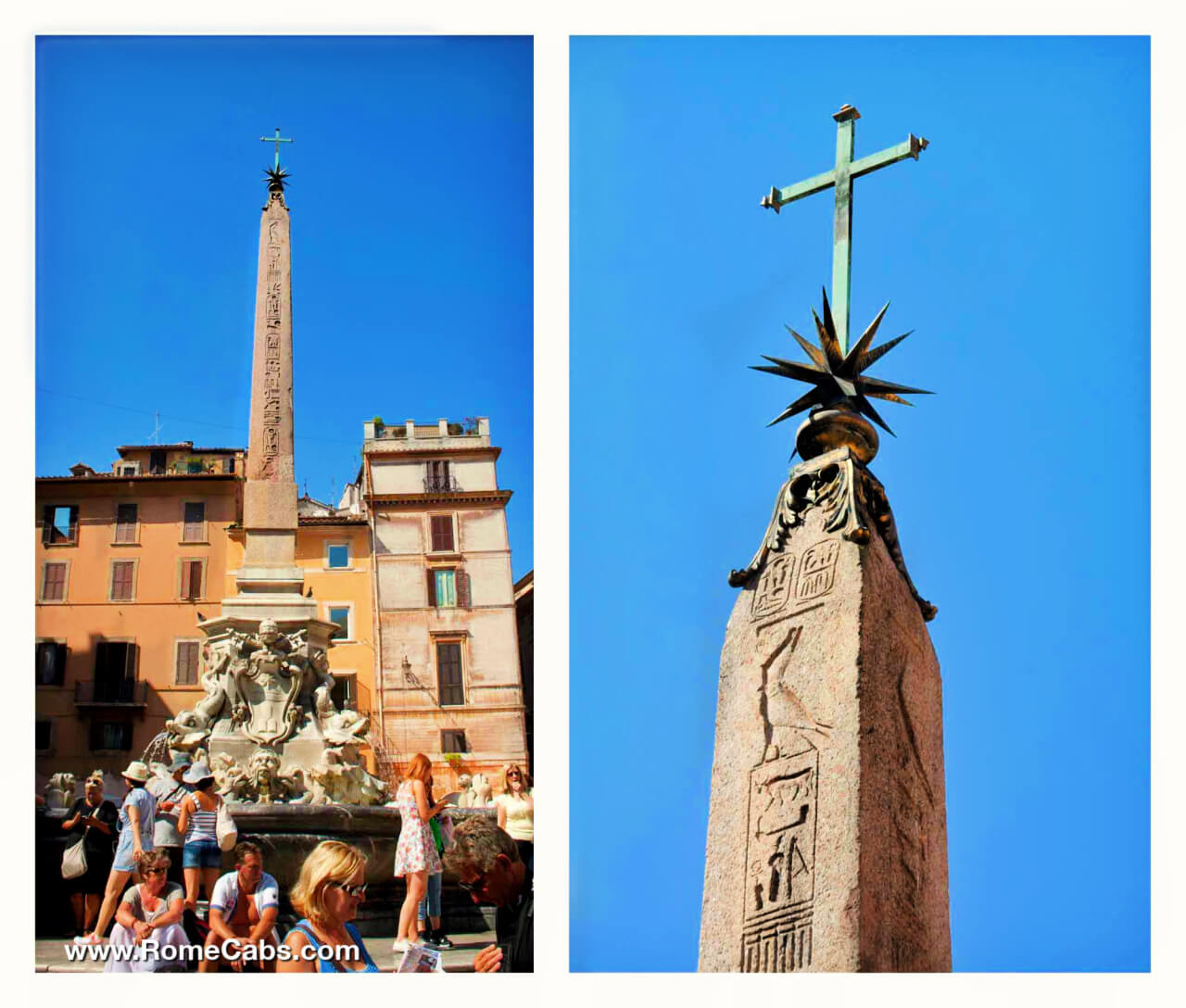10 Unique Facts about the Pantheon you probably didn’t know
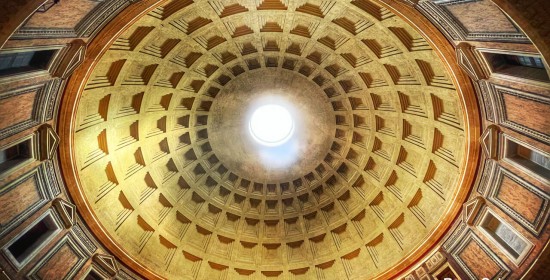
Buon giorno and welcome to Stefano's RomeCabs, Rome's leading company for private Day Tours from Rome, Shore Excursions from Civitavecchia, and private Transfers from Rome and beyond. Rome is so rich with magnificent and ancient monuments that it’s impossible to see everything in just one visit to the Eternal City. However, there is one special monument that is possibly on every traveler’s “must-see” list and a staple on our Panoramic Rome tour and Tour Rome as Romans Do: the Pantheon.
The magnificent and enigmatic Pantheon has inspired, mystified, amazed, and educated the world throughout its 2,000-year existence. From artists, architects, and historians… to simple locals and curious visitors, the Pantheon has evoked a feeling of ancient glory and immutability that has drawn people from all corners of the world to see and study it.
What does Pantheon mean? The meaning of the Pantheon derives from the Greek words pan and theon, which mean all and gods. Essentially, the Pantheon was dedicated to all gods.
What is the Pantheon? We may never discover all of the Pantheon’s ancient mysteries, but we can share some of its most fascinating secrets with you in this travel blog.
10 Unique Facts about the Pantheon you probably didn’t know
1. The Pantheon you see now is not the Original
Although the facade of the monument bears the sign “Agrippa made this”, what you see today was NOT built by Agrippa, nor does it resemble what Agrippa built. This important fact always amazes our clients visiting the Pantheon on our Rome tours.
M·AGRIPPA·L·F·COS·TERTIVM·FECIT
Marcus Agrippa, son of Lucius, made this building when consul for the third time.
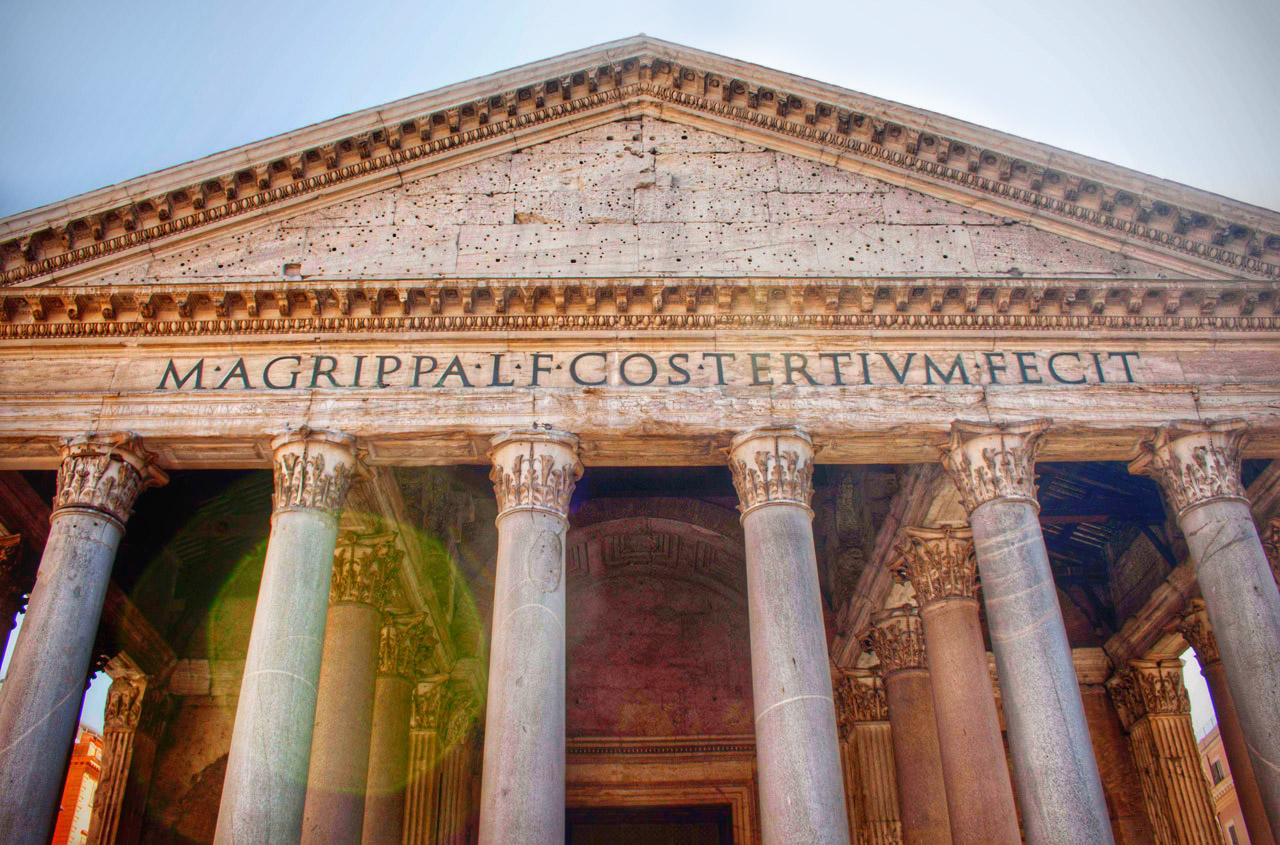
The famous monument you are looking at now is the 3rd temple.
The first ancient temple was built by Agrippa between 27-25 BC, but unfortunately, it was destroyed by a fire in 80 AD.
The second temple was rebuilt by Emperor Domitian, but it too was destroyed in the year 110 AD when it is said it was struck by lightning and burned down.
The final structure we see today was entirely rebuilt in 126 AD by Emperor Hadrian, utilizing more up-to-date architectural and engineering techniques.
In honor of its original builder Agrippa, Emperor Hadrian did not take credit for it by inscribing its own name on the building.
Whatever his true intention was, it caused confusion even during the ancient times when in approximately 200 AD the Pantheon was credited to Agrippa…it wasn’t until early 19th century excavations that the real builder of the temple was confirmed when bricks marked with dates during Emperor Hadrian’s time were discovered.
2. Read the “fine print” inscription on the pediment
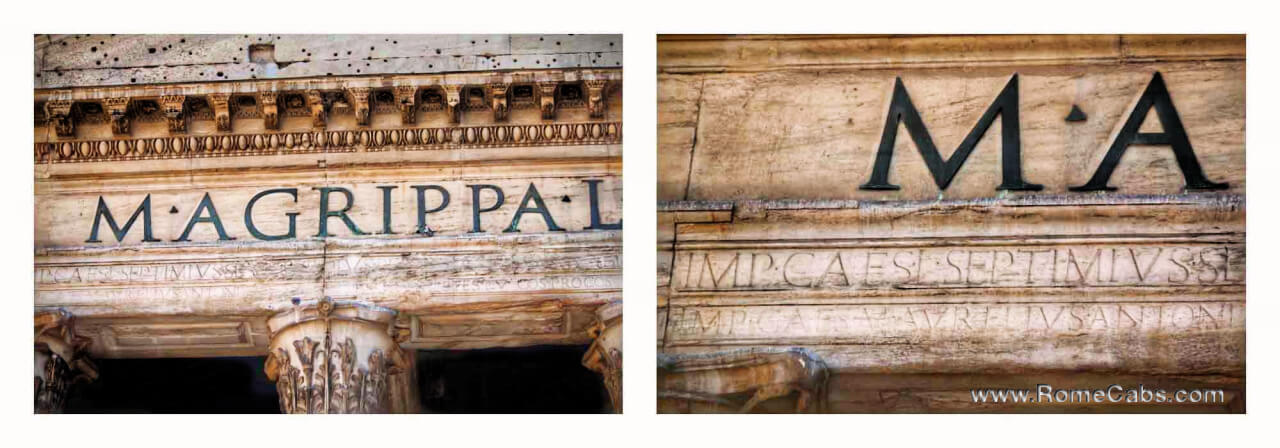
Even though the humble Emperor Hadrian, who actually built the Pantheon, did not inscribe his name on it, it didn’t stop Septimius Severus and his son and co-emperor Caracalla from making their restoration efforts in 202 AD known publicly.
Beneath the bold Marcus Agrippa inscription on the pediment, barely noticeable if you’re not actually looking for it, you will find the following engraved:
IMP[ERATOR] CAES[AR] L[UCIUS] SEPTIMIUS SEVERUS … ET IMP[ERATOR] M[ARCUS] AURELIUS ANTONINUS… PANTHEUM VETUSTATE CORRUPTUM CUM OMNI CULTU RESTITUERUNT
Emperor Lucius Septimius Severus… and Emperor Marcus Aurelius Antoninus… with each refinement, they restored the Pantheon, damaged by the passage of years.
3. The Pantheon was Saved from Destruction by….
With the Ancient Roman portion of the city’s historic center resembling a large archaeological site scattered with ruins, it’s incredible that the Pantheon has remained perfectly intact after 2,000 years, and only suffered superficial damages as a result of the pillaging of marble, sculptures, and metals during the Medieval and Renaissance Eras.
What saved this previous monument from a fate similar to the Colosseum that left it devastated by neglect and quarried for materials to build palaces and churches in Rome, the saving grace of the Pantheon came in from of a gift from Byzantine Emperor Phocas to Pope Boniface IV in 609 AD who in turn converted the ancient pagan temple into a Christian church and consecrated to Saint Mary of the Martyrs (Santa Maria ad Martyres).
As a result, the Pantheon has become the best-preserved ancient monument to be in continuous use throughout its history since 127 AD.
4. Pantheon, a geometric wonder: A Sphere within a Cylinder
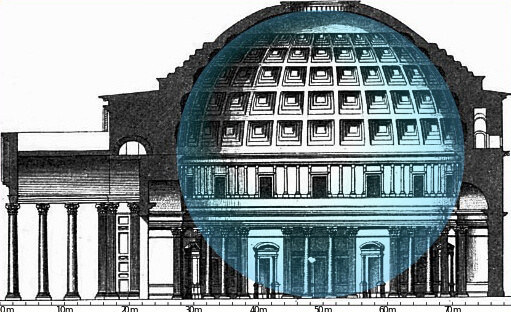
Romans were preoccupied with symmetry and space.
Did you know that you could fit a sphere 142 feet in diameter inside the Pantheon and it would fit perfectly?
That’s because the height from the floor to the oculus and the diameter of the rotund interior is 142 feet.
Likewise, the whole interior of the Pantheon would also fit perfectly within a cube 142 feet in diameter.
The sphere within a cylinder model is one of Archimedes’ great mathematical discoveries, demonstrating the theory of the 2:3 correlation between the volume of a sphere and a cylinder.
Consequently, the dome of this structure starts at the halfway point of the building, however, a third of the dome is embedded into the drum.
5. The Pantheon: A pagan temple, a Christian church, and a Tomb?
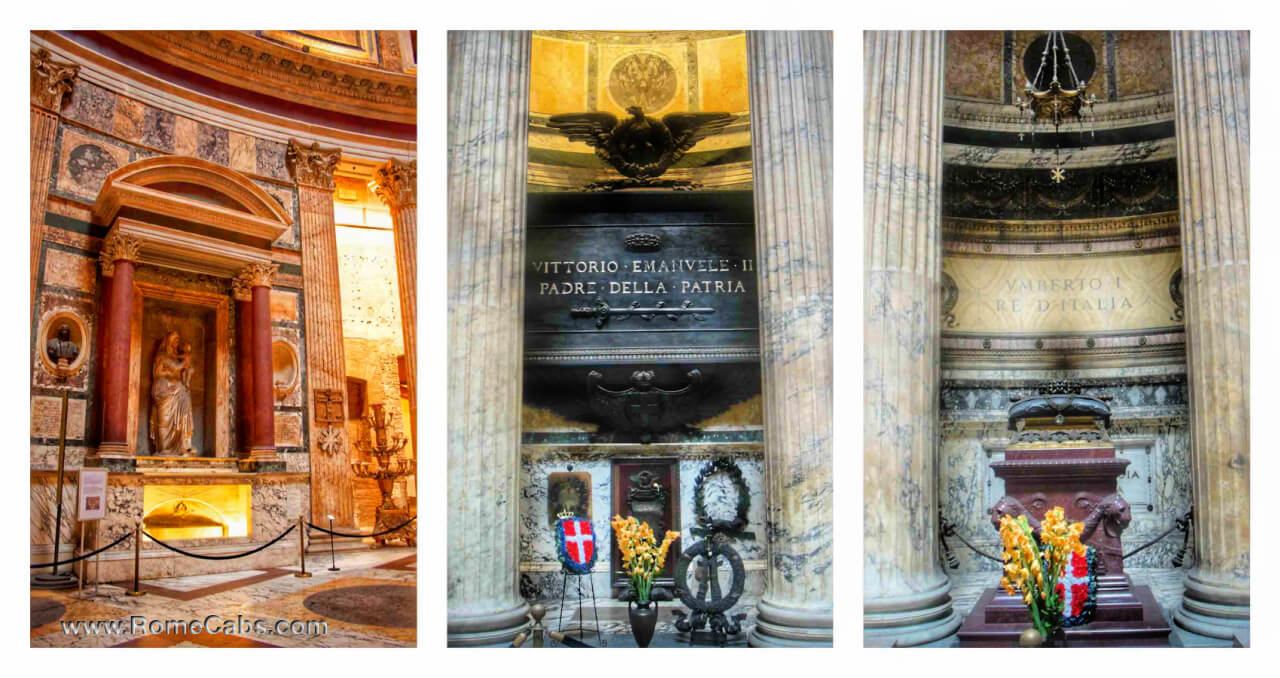
We know that the literal translation of the Pantheon means “dedicated to all gods”, therefore it’s assumed by many that indeed this ancient temple was dedicated to ALL pagan gods.
This assumption has been questioned by many, and uncertainty caused even some 3rd century AD writers such as Roman senator Cassius Dio to speculate the true meaning of its name because it was not believed to be possible to properly worship ALL gods in one temple.
One of the Pantheon’s great unsolved mysteries is its true purpose, and whether it was used for religious or ceremonial functions.
This uncertainty arose from the lack of finding the word aedes (the dwelling place of a god) used by ancient authors in reference to Hadrian’s Pantheon as they did in reference to other Roman temples of worship…. and historical findings indicate that Hadrian held court inside the temple which seemed to have served as an audience hall.
After the temple was converted into a Christian church, it also served as a tomb for some of Italy’s most illustrious figures such as Italy’s kings Vittorio Emanuele II (the first kind of unified Italy), his successor Umberto I, Umberto’s Queen Margherita, and the great Renaissance painter Raphael.
Queen Margherita is also credited for being the inspiration for Italy’s famous Pizza Margherita featuring Italy’s flag colors: White (mozzarella), Red (tomatoes) and Green (basil).
Nowadays though, Raphael‘s tomb gets more tourist attention than the Kings of Italy combined.
6. See what the Pantheon looked like in Ancient Rome
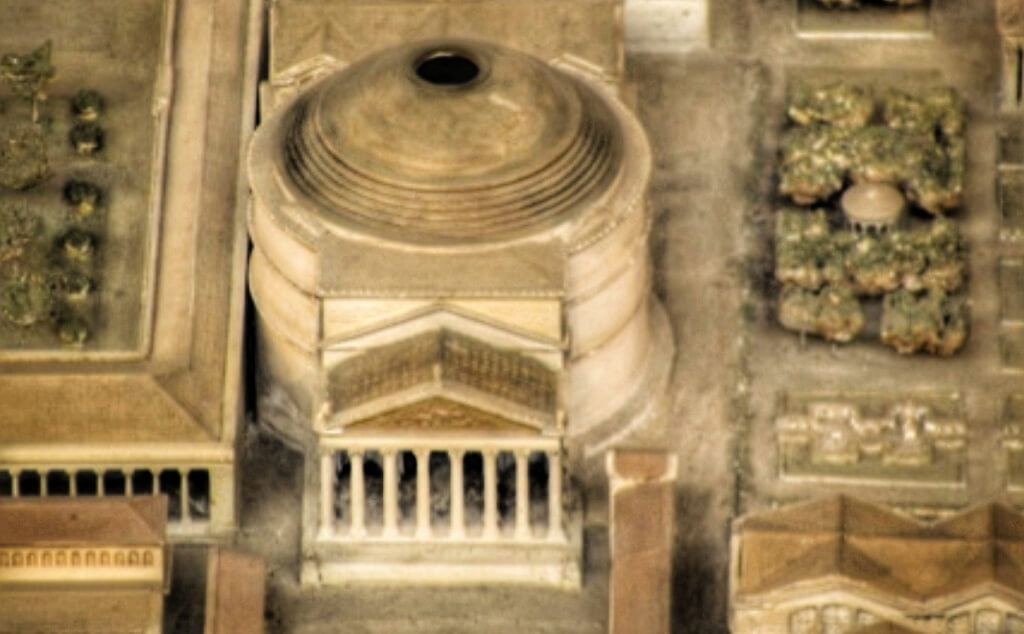
This ancient temple is so well preserved that it’s not too difficult to imagine what it looked like in all it’s ancient glory.
The interior is almost entirely intact, and what you see today is not much different (aside from the added Christian elements and missing Ancient Roman artifacts) from what an ancient Roman would have seen when entering this impressive monument nearly 2,000 years ago!
The greatest amount of damage has been done to its facade as it’s been stripped of marble and metals (such as bronze) used as materials for projects around Rome during the Medieval and Renaissance Eras.
The famous quote: “quod non fecerunt barbari, fecerunt Barberini” – “What the barbarians didn’t do, the Barberini did” says it all.
Barberini was the famous and wealthy family of Pope Urban VIII who, in the 1600s, stripped the bronze ceiling of the portico and melted it in order to build cannons (although, some claim the bronze was used to create Bernini’s famous baldachino – the giant canopy above the altar in St Peter’s Basilica).
But thanks to the Museum of Roman Civilization in Rome’s EUR district, a large scale model of Ancient Rome as it existed under Emperor Constantine shows not only what the Pantheon looked like in the early 4th century AD, but how it fits into its ancient neighborhood and other structures that are now long gone.
7. Piazza della Rotonda …it’s not what it used to be!
The lively square in front of the monument is named Piazza della Rotonda…a name not representative of the shape of the square which is rectangular, but an extension of the church’s unofficial medieval name Santa Maria Rotonda (nicknamed for its “rotund” shape).
Although Piazza della Rotonda attracts many visitors and locals who enjoy leisurely meals at the open-air cafes and linger on the steps of its central fountain to relax, people watch, and admire the monument, this famous square was not nearly as clean and inviting as today.
For centuries the monument was forced to endure a most dreadful sight: a cacophony of taverns, inns, sheds, and shops obstructing the space around the monument with vendors (legal and illegal) selling everything from vegetables to birds and poultry, revolting odors emanating from stalls, slippery pavement covered by filth, and thieves preying on Romans.
The only things that have remained constant throughout the square’s history are the unlicensed vendors and occasional pickpockets that seem to never permanently go away.
This loathsome market that overpowered the monument was finally demolished and the square was restored in the early 1800s by Pope Pius VII who left this large plaque on the wall of the building facing the Pantheon as a reminder of his clean-up job. You too can see this plaque when you visit the square:
PIVS · VII · P · M · AN · PONTIFICATVS · SVI · XXIII ·
AREAM · ANTE · PANTHEON · M · AGRIPPAE IGNOBILIBVS · TABERNIS
DEMOLITIONE · PROVIDENTISSIMA
AB · INVISA · DEFORMITATE · VINDICAVIT
ET · IN · LIBERVM · LOCI · PROSPECTVM · PATERE · IVSSIT
Pius VII Supreme Pontiff, in the 23rd Year of His Pontificate the 23rd,
freed the area of the Pantheon of Marcus Agrippa
of the ignoble businesses by undertaking a very thoughtful program of demolition
to render clear the view of the site.
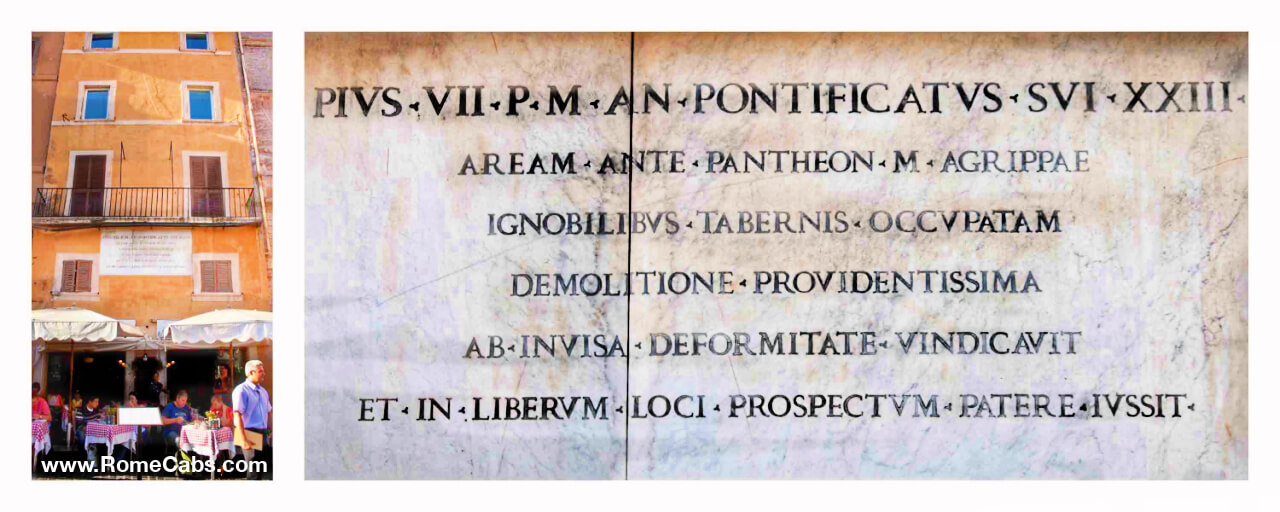
8. Famous movies filmed at the Pantheon
Rome and its impressive monuments, squares, fountains, museums, and churches have been the subject of and served as backdrops for many films. Some films are famous and some are not so much.
The Pantheon was featured in two famous movies most visitors to Rome have watched: the classic Vacanze Romane (Roman Holiday), and the thriller Angels and Demons.
On the right side facing the monument was the cafe scene in the movie Vacanze Romane when Princess Ann (Audrey Hepburn) and Joe Bradley (Gregory Peck) met his photographer friend Irving Radovich (Eddie Albert) for drinks so he can secretly take photos of Princess Ann for an exclusive story Bradley was secretly planning to write for the newspaper he worked for as a reporter.
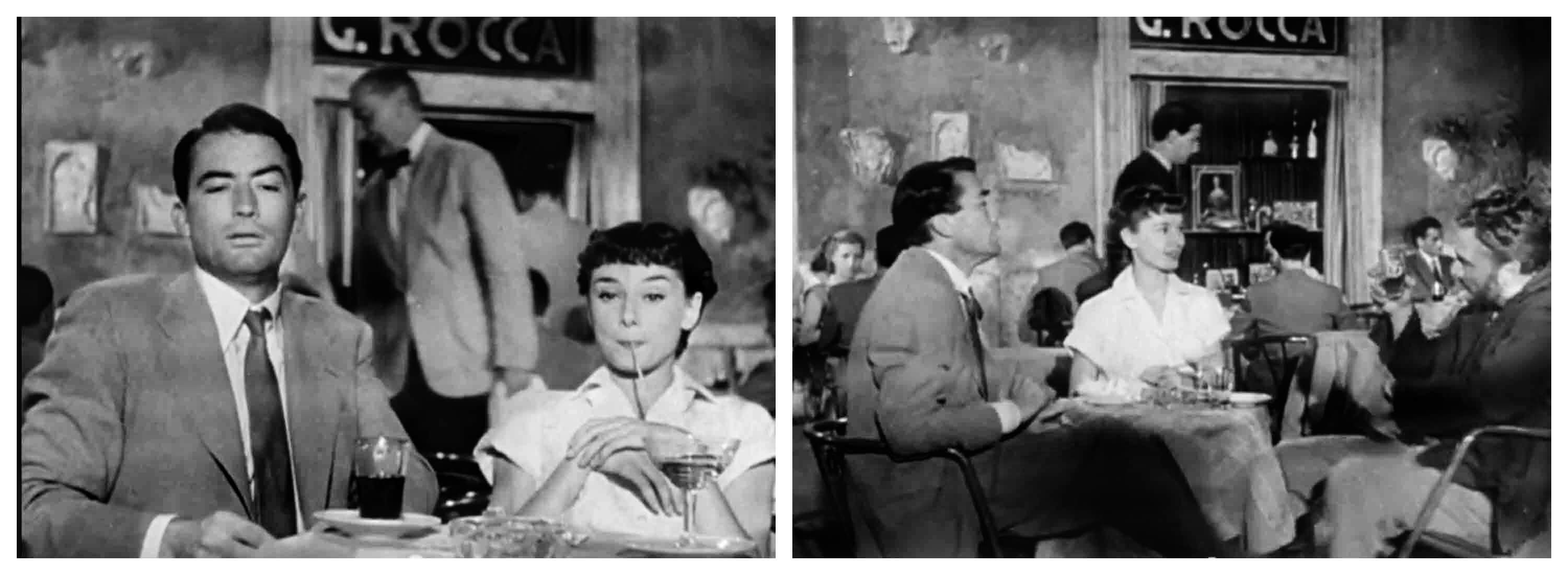
It’s easy to find this spot… just look for the gelateria “Cremeria Monte Forte”. And while there, stop in for gelato, it’s a local favorite.
In Angels and Demons novel and movie, in his search for the Altar of Science, the protagonist Robert Langdon and his partner Vittoria go to the Pantheon first with the belief that the Pantheon is the Altar of Science where a Cardinal is due to be killed after following the first line in the poem: “From Santi’s earthly tomb with demon’s hole”.
Santi is the last name of the famous Renaissance painter Raphael whose tomb is inside the Pantheon. Langdon believed that the “demon hole” could have been the oculus. However, this error was rectified when it was revealed by a local guide that Raphael designed a tomb (an earthy tomb) inside the church of Santa Maria del Popolo where the famous demon hole was also discovered.
For fans of these two movies, consider a day tour from Rome with our sister company Stefano Rome Tours offers full-day tours highlighting the most important places featured in these movies:
Vacanze Romane (Full Day tour from Rome and Shore Excursion from Civitavecchia)
Angels and Demons (Full Day tour from Rome and Shore Excursion from Civitavecchia)
9. Famous buildings inspired by the Pantheon

The Pantheon has not only inspired the Renaissance masters like Brunelleschi and Michelangelo to create the domes of the Duomo of Florence and St Peter’s Basilica, but it has inspired contemporary architects who paid homage to the ancient monument.
Here are 5 famous buildings that were inspired by the Pantheon:
Jefferson Memorial – a presidential memorial in Washington DC dedicated to Thomas Jefferson, American Founding Father, and 3rd US President.
Low Memorial Library - administrative center of Columbia University built in 1895 by university president Seth Low.
National Gallery of Art - national art museum in Washington DC located on the National Mall.
US Capitol – the seat of the United States Congress was completed in the year 1800 in a neoclassical style.
Panthéon in Paris - originally built as a church dedicated to St. Genevieve in Paris, now is a secular mausoleum.
10. Egyptian Obelisk in front of the Pantheon
The obelisk erected on top of the fountain in front of the Pantheon was not carved out as part of the fountain design, it’s an actual Egyptian obelisk…one with a fascinating story.
In 30 BC Roman Emperor Augustus conquered Egypt after defeating Caesar and Cleopatra, further extending Rome’s conquest. Looting by the victorious army has been common throughout history, and spoils of war were part of the celebration of victory and power over the conquered land.
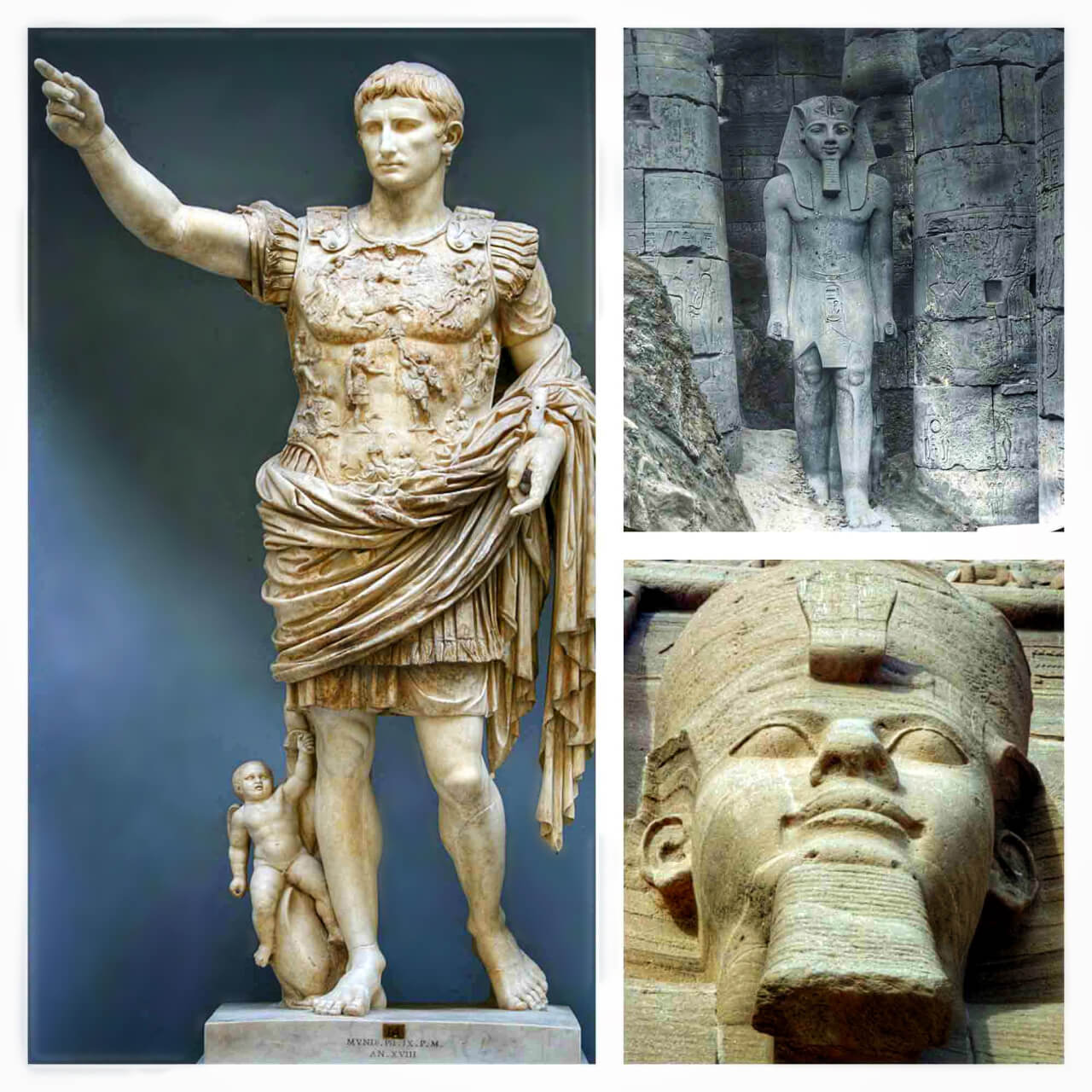
Even before the Augustan conquest, travel to Egypt by Romans was common for reasons of commerce, religious pilgrimages, military, and tourism (ancient graffiti indicated touristic itineraries to various sites of interest).
And Roman tourists brought with them “souvenirs” such as papyri scrolls, statuettes, and other Egyptian objects that were displayed in temples or other locations. Tourism and souvenirs are NOT a modern concept, as ancient history demonstrates….
The Egyptian obelisk was something that fascinated the victorious Romans: it symbolized the relationship between the gods and the pharaohs.
The obelisk itself is believed to have represented a solid ray of sunlight, a vessel for communications between the realms of heavenly gods and Earthly mortals. Obelisks were often erected in front of temples dedicated to Ra, the Egyptian sun god…and therefore, many Egyptian obelisks that were brought to Rome were taken from such temples in the city Heliopolis – literally, the “city of the sun”.
Not an easy feat to bring them from Egypt to Rome, these monolithic structures were likely transported on barges along the Nile river and across the Mediterranean sea to Rome – an ancient Roman engineering feat it itself considering an obelisk weighed hundreds of tons!
And such was the fate of a pair of obelisks originally constructed by the Egyptian Pharaoh Ramses II for the Temple of Ra in Heliopolis. These 2 obelisks were brought to Rome by Emperor Diocletian for the nearby Temple of Isis. If you’re wondering why a temple dedicated to an Egyptian deity existed in Rome near the Pantheon, Rome was once largely populated by Egyptian migrants. Much like today, ancient Rome was multi-cultural.
Time was not kind to this obelisk as in the late 14th century it was found underneath the apse of Basilica Santa Maria Sopra Minerva located just behind the Pantheon. It was erected in the Piazza di San Macuto about 200 meters east of the Pantheon where it stood until it was moved to its present location in 1711 by Pope Clement XI and positioned on top of the fountain of Piazza della Rotonda. In memory and honor of its previous location, the obelisk is formally called “Obelisk Macuteo”.
If you’re curious about where the mate of this obelisk is, all you have to do is walk behind the Pantheon to Piazza della Minerva. You will see it erected on Bernini’s famous elephant base.
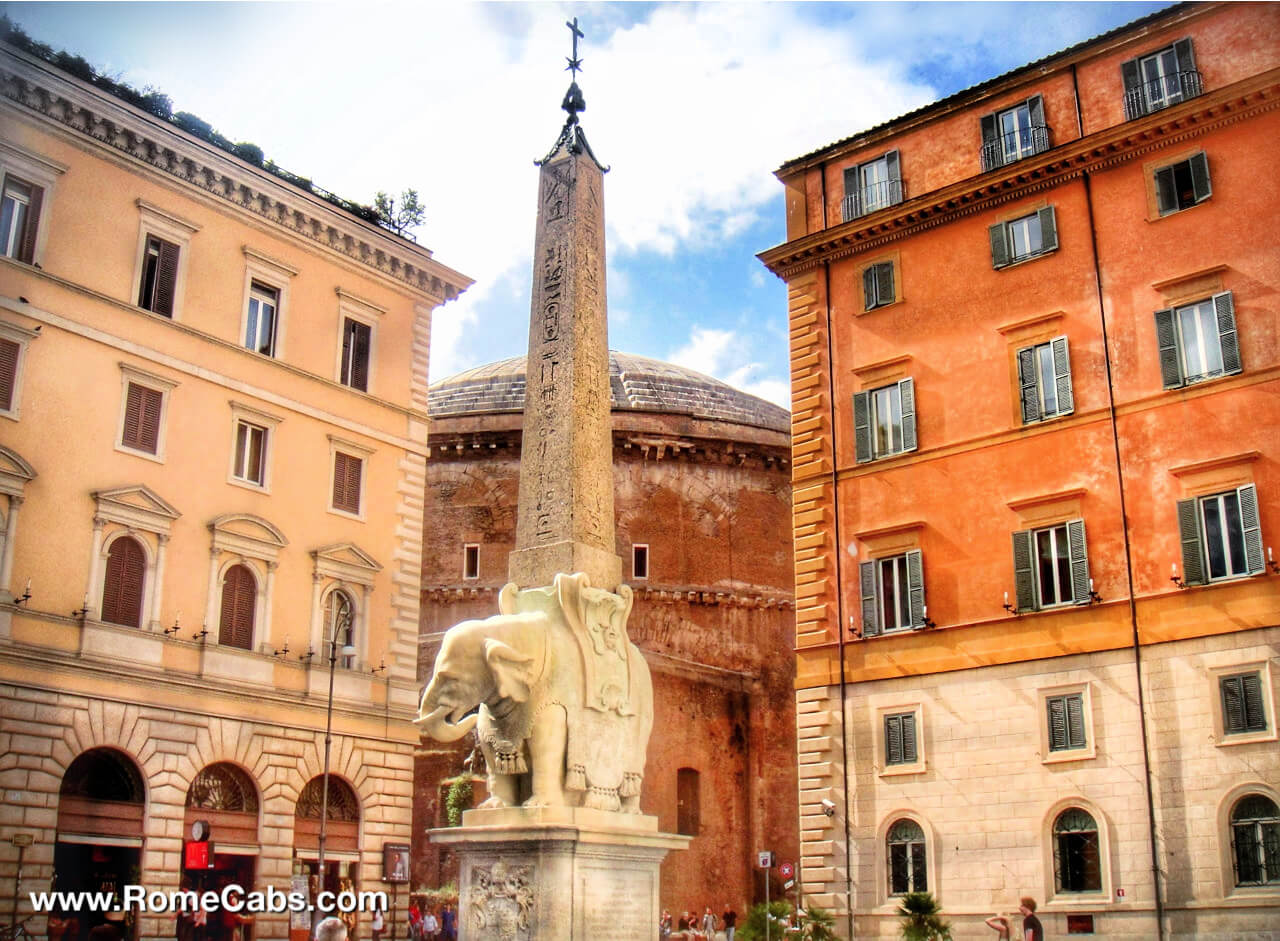
There are 13 obelisks in Rome, many of them erected in front of prominent churches as part of elaborate projects initiated by several Popes during the 16th-18th centuries who restored the buried and forgotten obelisks and transformed them into symbols of Christianity triumphing over ancient paganism (as it has been done when converting pagan temples such as the Pantheon into Christian churches, thus preserving them so they can be enjoyed today).
Christian and even Papal symbols can be seen crowning the top of the obelisks.
This ancient sentinel standing tall in front of the Pantheon has witnessed many layers of history from ancient Egyptian pharaohs to Roman emperors, then resurrected by Christian Popes after centuries of neglect…..and nowadays photographed by tourists with their iPhones and cameras.
See the Pantheon on RomeCabs Private Tours of Rome &
Shore Excursions from Civitavecchia
RomeCabs provides a range of popular Day Tours by Car, Civitavecchia Shore Excursions, and VIP Rome Airport Transfers that offer the opportunity to admire the Pantheon and experience the lively Piazza della Rotonda.
With our exceptional service, your personal English-speaking driver will take you straight to the heart of Rome, dropping you off just steps from the Pantheon. From there, you can marvel at this ancient architectural masterpiece and soak in the dynamic atmosphere of the surrounding square, where centuries of history meet the vibrancy of contemporary life.
Panoramic Rome Tour for Cruisers - Enjoy the highlights of Rome in the comfort of your private vehicle and maximize your sightseeing while minimizing the walking and fatigue of traveling from place to place. This tour is perfect for those who have limited time in Rome, want to see as much as possible in a day, or don’t want to deal with public transportation and walking long distances.
Rome Town and Country Tour - Delight in Rome's most iconic squares, including a visit to Piazza della Rotonda to admire the Pantheon. In the afternoon, escape to the serene beauty of the medieval countryside, exploring the charming village of Ceri, the historic town of Bracciano, and the impressive Orsini-Odescalchi Castle.
Rome Pre-Cruise Tour - Make the most of your morning in Rome by combining a half-day tour of Rome with a transfer to the cruise port of Civitavecchia.
VIP Transfers - Enhance your airport transfer into Rome with the option of a 2-hour mini-tour of Rome, or a 4-Hour mini-tour with an English-speaking driver.
Thank you so much for stopping by and reading our blog 10 Unique Facts about the Pantheon you probably didn’t know.
If we can help make your visit to Italy better, please visit our website or contact us via email.
For travelers seeking transportation from Rome, RomeCabs is pleased to also offer:
See you soon in Italy!
The Rome Cabs Team
Also Find RomeCabs online at:
- RomeCabs Facebook: https://www.facebook.com/RomeCabsToursAndTransfers
- RomeCabs Pinterest: https://www.pinterest.it/romecabs
- RomeCabs Twitter: https://twitter.com/RomeCabs
- RomeCabs Instagram: https://www.instagram.com/romecabs/
- RomeCabs Flickr Photos: https://www.flickr.com/photos/romecabs/
- RomeCabs Recommended on Cruise Critic
